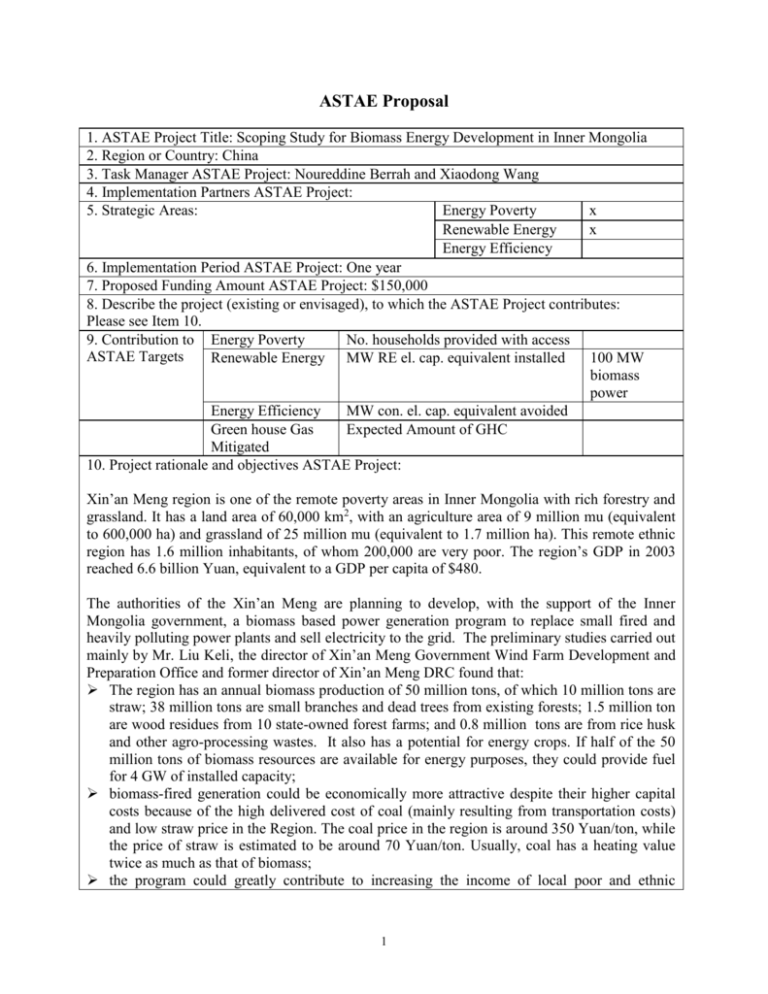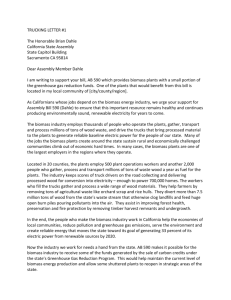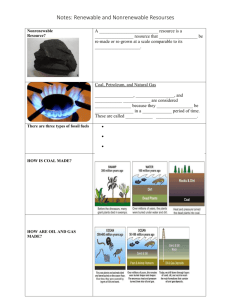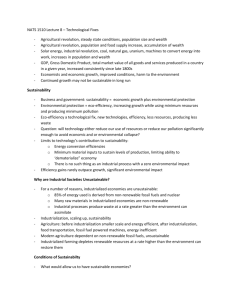ASTAE Proposal
advertisement

ASTAE Proposal 1. ASTAE Project Title: Scoping Study for Biomass Energy Development in Inner Mongolia 2. Region or Country: China 3. Task Manager ASTAE Project: Noureddine Berrah and Xiaodong Wang 4. Implementation Partners ASTAE Project: 5. Strategic Areas: Energy Poverty x Renewable Energy x Energy Efficiency 6. Implementation Period ASTAE Project: One year 7. Proposed Funding Amount ASTAE Project: $150,000 8. Describe the project (existing or envisaged), to which the ASTAE Project contributes: Please see Item 10. 9. Contribution to Energy Poverty No. households provided with access ASTAE Targets Renewable Energy MW RE el. cap. equivalent installed 100 MW biomass power Energy Efficiency MW con. el. cap. equivalent avoided Green house Gas Expected Amount of GHC Mitigated 10. Project rationale and objectives ASTAE Project: Xin’an Meng region is one of the remote poverty areas in Inner Mongolia with rich forestry and grassland. It has a land area of 60,000 km2, with an agriculture area of 9 million mu (equivalent to 600,000 ha) and grassland of 25 million mu (equivalent to 1.7 million ha). This remote ethnic region has 1.6 million inhabitants, of whom 200,000 are very poor. The region’s GDP in 2003 reached 6.6 billion Yuan, equivalent to a GDP per capita of $480. The authorities of the Xin’an Meng are planning to develop, with the support of the Inner Mongolia government, a biomass based power generation program to replace small fired and heavily polluting power plants and sell electricity to the grid. The preliminary studies carried out mainly by Mr. Liu Keli, the director of Xin’an Meng Government Wind Farm Development and Preparation Office and former director of Xin’an Meng DRC found that: The region has an annual biomass production of 50 million tons, of which 10 million tons are straw; 38 million tons are small branches and dead trees from existing forests; 1.5 million ton are wood residues from 10 state-owned forest farms; and 0.8 million tons are from rice husk and other agro-processing wastes. It also has a potential for energy crops. If half of the 50 million tons of biomass resources are available for energy purposes, they could provide fuel for 4 GW of installed capacity; biomass-fired generation could be economically more attractive despite their higher capital costs because of the high delivered cost of coal (mainly resulting from transportation costs) and low straw price in the Region. The coal price in the region is around 350 Yuan/ton, while the price of straw is estimated to be around 70 Yuan/ton. Usually, coal has a heating value twice as much as that of biomass; the program could greatly contribute to increasing the income of local poor and ethnic 1 inhabitants; and improve the local and global environment by displacing high-sulfur coal and avoiding field burning of important amounts of biomass residues. Based on these preliminary studies, the local authorities have an ambitious plan to develop 10x100MW of biomass-fired power generation and co-generation units to replace all small coal power plants in the near term, and more in the future. The annual electricity consumption for the Xin’an Meng Region is 500 GWh, currently with power supply from three sources: 1) 160 GWh/yr from local thermal and hydro generation; 2) 180 GWh/yr import from the China Northeast Grid; and 3) 160 GWh/yr from the Inner Mongolia Grid. The tariff is around 0.33-0.35 Yuan/kWh in township areas, 0.60 Yuan/kWh in rural areas, and 0.8-0.85 Yuan/kWh in forest farms. In addition, there is an increasing demand for heating services in township areas. During the pre-appraisal mission of the China Renewable Energy Scale-Up Program (CRESP), the local government requested World Bank support to implement this ambitious plan for biomass development in the region, possibly under the second phase of CRESP. CRESP supports development of a policy framework to scale up renewable energy as well as investment in renewable energy capacity. It will also support improving the quality and performance of renewable energy equipment and strengthen the capacity of renewable energy industries so that they are able to respond to sharply increased market demand. Based on Chinese government priorities, CRESP would focus on investment projects in grid-connected wind, biomass, and small hydro. Further studies are required to assist the local government in preparing the project for the second phase of CRESP. 11. Expected outcomes: A scoping study report including 1) resource assessment; 2) regional potential for biomass power; 3) regional market evaluation; 4) project identification, pre-feasibility study and other preparation activities; and 5) possibly a PCN for carbon financing. This study is expected to lead to a Bank investment project, either under CRESP phase II or stand-alone, and possibly a carbon financing project. 12. Planned activities to achieve outcomes: Collect available information on current biomass use for energy production, with a particular focus on low cost agricultural residues and weeds, which don’t compete with other uses, including such products as Ipomea Assess the potential of biomass residues: including but not limited to: confirmation of biomass resources in the region; biomass resource availability for energy purposes and existing competing uses; sites and resource information of centralized facilities that generate biomass residues such as forest farms and rice mills; Analysis the most efficient way of transporting biomass resources. (Experience in India has shown that baling of straw resources might not be the most cost effective methods of transporting straw.) 2 potential straw costs and costs of other biomass resources, breaking down into costs for fuel, collection, baling, and transportation; risk mitigation measures for variable price of straw and other potential sources; feasibility of collection mechanisms for straw and potential other sources of biomass; and fuel content, heating value, and characteristics analysis, including calculations of the possible mixes during the year due the variations in the availability of biomass resources throughout the year, to produce a consistent and efficient fuel mass. Based on the optimal mix by month, provide cost forecasts for the different mixes by month as input to the feasibility study. Asses the potential for the utilization and sale of the ash residues for bio-fertilizer Assess the potential of energy crops: including land availability for energy crops and competing use; yield and species of energy crops; and economic and financial analysis of energy crops Based on the above resource assessment and evaluation of small coal-fired power plants in the region, assess the economically and financially justified biomass power capacity to be developed to replace these small coal fired plants. Assess the regional market: Who and where will buy the surplus electricity generated at what price Identify project sites and conduct pre-feasibility study on project scale, fuel supply, load demand, implementing agency, power off-taker, project costs, technical and financial feasibility, etc. Identify project sponsors Evaluate biomass power or cogen technologies Evaluate the environmental benefits and possibilities for trading of carbon credits on national and international markets. If possible for carbon financing, prepare project concept note. 11. Project linkage to national priorities, action plans, and programs: During the 2004 World Renewable Energy Meeting in Bonn from June 1-4, 2004, the Chinese Government announced that China would start to develop the Renewable Energy Promotion Law to speed up the development and utilization of renewable energy. By 2020, the share of renewable energy in the primary energy production will occupy 10%. China is now drafting the Mid and Long Term Plan on Renewable Energy Development and has incorporated such a plan into the national economic development plan. This will clarify the strategic objective of the renewable energy development; remove market barriers and firm up the incentive measures for renewable energy development; it will also help to create the social and cultural environment for renewable energy development and promote the commercialization and scaled development of renewable energy. According to the Mid and Long Term Plan on Renewable Energy Development, the development target by the year 2020 are: the installed capacity of small hydro power will reach 75 GW and will replace an annual consumption of 80 million tons of standard coal; the installed capacity of wind power will reach 20 GW and will replace an annual consumption of 15 million tons of standard coal; the installed capacity for biomass power will reach 20 GW and will replace an 3 annual consumption of 28 million tons of standard coal, and the total installed capacity of PV systems will reach 1,000 MW. Based on the target mentioned above, the Chinese government is trying to speed up the pilot projects on wind power concession and biomass power generation. To accelerate the development of renewable energy, the Chinese Government hopes to obtain financial and technical support from international organizations such as the World Bank and GEF. China is keen to learn from international experiences and practices. The Chinese Government is willing to promote the commercialization and scale up of renewable energy development jointly with the international world and contribute to the sustainable development of the economy. The government endorsement of CRESP project is a good example to demonstrate national support to renewable energy. Under this context, this proposed project is in line with Chinese government priority, and can provide a demonstration of scaling up biomass development in China. In addition, this project can also address poverty alleviation issues in remote minority areas by creating job opportunities and increasing incomes for local inhabitants. 12. Stakeholders involved in project: In Xin’an Meng: Development and Reform Commission (DRC), Government Wind Farm Development and Preparation Office, Agriculture and Forestry Department, local utility, forest farms, agriculture mills, rural farmers, and etc. Inner Mongolia DRC and Agriculture and Forestry Department, Inner Mongolia and Northeast Grid. 13. Implementation arrangement: Noureddine Berrah and Xiaodong Wang will provide overall supervision of this work. International and local consultants on forestry and biomass combustion will be hired. 14. Total budget and information on how costs will be met: International consultants: $100,000 Local consultants: $ 50,000 Total: $150,000 (including travel costs) 15. Reporting, The Consultants will provide hard and soft copies of reports as specified in the TOR in Enlish, in such a way that it can provide a model for similar studies in other parts of China and East Asia. These would include power point presentations, short videos and pictures. The reports will acknowledge the support of ASTAE. 15. Added value of ASTAE support (what difference does the ASTAE support make?): ASTAE support would help the local government develop the project concept through resource assessment, regional market evaluation, and project identification and pre-feasibility study. Without ASTAE support, this project may not materialize. ASTAE funding is expected to leverage significant follow-up Bank investment. 16. Other possible contributors/ donors and amounts: 17. Expected Follow-up: Investment project under CRESP II or stand-alone investment project, and/or carbon financing project 4








